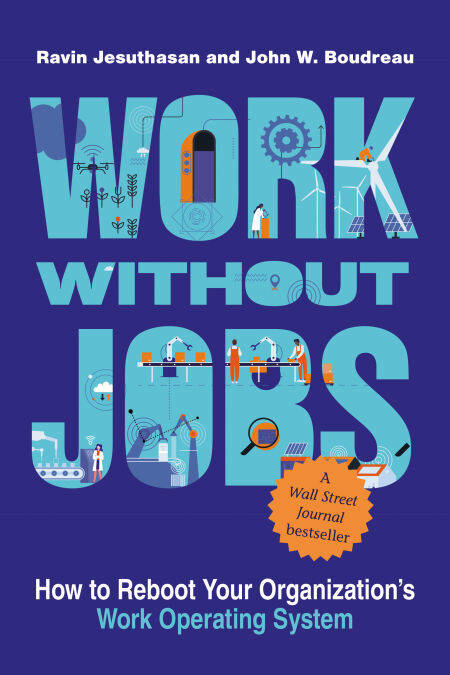
- Afhalen na 1 uur in een winkel met voorraad
- Gratis thuislevering in België vanaf € 30
- Ruim aanbod met 7 miljoen producten
- Afhalen na 1 uur in een winkel met voorraad
- Gratis thuislevering in België vanaf € 30
- Ruim aanbod met 7 miljoen producten
Zoeken
Work without Jobs E-BOOK
How to Reboot Your Organization’s Work Operating System
Ravin Jesuthasan, John W. Boudreau
€ 22,62
+ 22 punten
Uitvoering
Omschrijving
In this Wall Street Journal bestseller, why the future of work requires the deconstruction of jobs and the reconstruction of work.
Work is traditionally understood as a “job,” and workers as “jobholders.” Jobs are structured by titles, hierarchies, and qualifications. In Work without Jobs, the Wall Street Journal bestseller, Ravin Jesuthasan and John Boudreau propose a radically new way of looking at work. They describe a new “work operating system” that deconstructs jobs into their component parts and reconstructs these components into more optimal combinations that reflect the skills and abilities of individual workers. In a new normal of rapidly accelerating automation, demands for organizational agility, efforts to increase diversity, and the emergence of alternative work arrangements, the old system based on jobs and jobholders is cumbersome and ungainly. Jesuthasan and Boudreau’s new system lays out a roadmap for the future of work.
Work without Jobs presents real-world cases that show how leading organizations are embracing work deconstruction and reinvention. For example, when a robot, chatbot, or artificial intelligence takes over parts of a job while a human worker continues to do other parts, what is the “job”? DHL found some answers when it deployed social robotics at its distribution centers. Meanwhile, the biotechnology company Genentech deconstructed jobs to increase flexibility, worker engagement, and retention. Other organizations achieved agility with internal talent marketplaces, worker exchanges, freelancers, crowdsourcing, and partnerships. It’s time for organizations to reboot their work operating system, and Work without Jobs offers an essential guide for doing so.
Work is traditionally understood as a “job,” and workers as “jobholders.” Jobs are structured by titles, hierarchies, and qualifications. In Work without Jobs, the Wall Street Journal bestseller, Ravin Jesuthasan and John Boudreau propose a radically new way of looking at work. They describe a new “work operating system” that deconstructs jobs into their component parts and reconstructs these components into more optimal combinations that reflect the skills and abilities of individual workers. In a new normal of rapidly accelerating automation, demands for organizational agility, efforts to increase diversity, and the emergence of alternative work arrangements, the old system based on jobs and jobholders is cumbersome and ungainly. Jesuthasan and Boudreau’s new system lays out a roadmap for the future of work.
Work without Jobs presents real-world cases that show how leading organizations are embracing work deconstruction and reinvention. For example, when a robot, chatbot, or artificial intelligence takes over parts of a job while a human worker continues to do other parts, what is the “job”? DHL found some answers when it deployed social robotics at its distribution centers. Meanwhile, the biotechnology company Genentech deconstructed jobs to increase flexibility, worker engagement, and retention. Other organizations achieved agility with internal talent marketplaces, worker exchanges, freelancers, crowdsourcing, and partnerships. It’s time for organizations to reboot their work operating system, and Work without Jobs offers an essential guide for doing so.
Specificaties
Betrokkenen
- Auteur(s):
- Uitgeverij:
Inhoud
- Aantal bladzijden:
- 232
- Taal:
- Engels
- Reeks:
Eigenschappen
- Productcode (EAN):
- 9780262368230
- Verschijningsdatum:
- 28/03/2022
- Uitvoering:
- E-book
- Beveiligd met:
- Adobe DRM
- Formaat:
- ePub

Alleen bij Standaard Boekhandel
+ 22 punten op je klantenkaart van Standaard Boekhandel
Beoordelingen
We publiceren alleen reviews die voldoen aan de voorwaarden voor reviews. Bekijk onze voorwaarden voor reviews.








